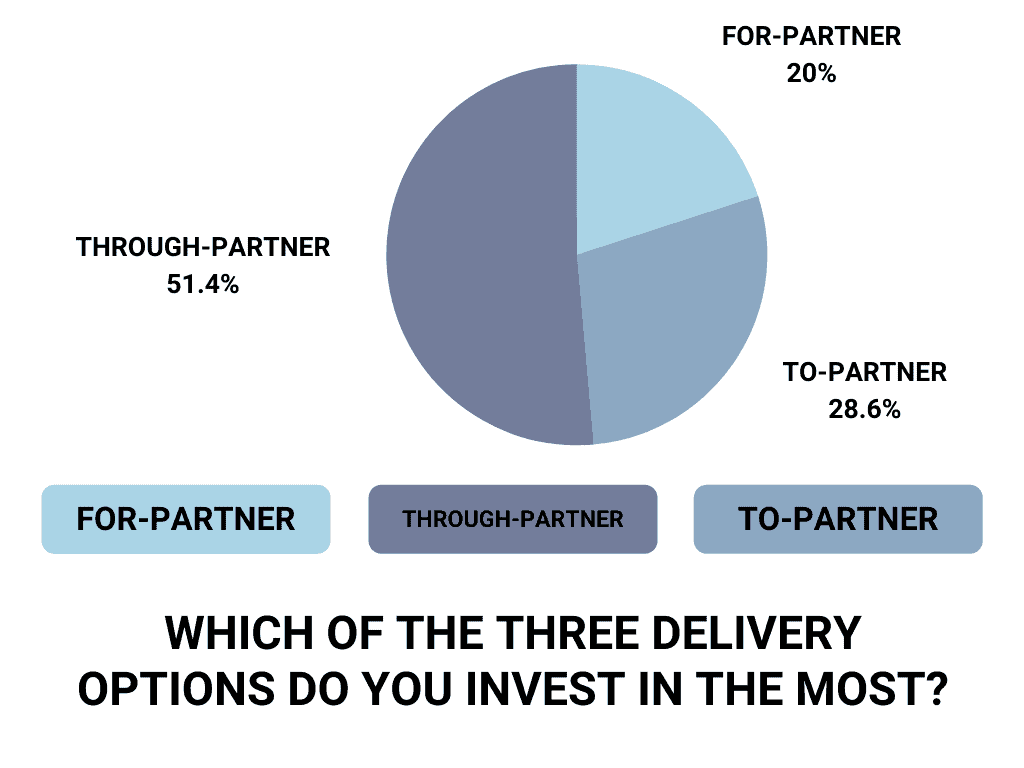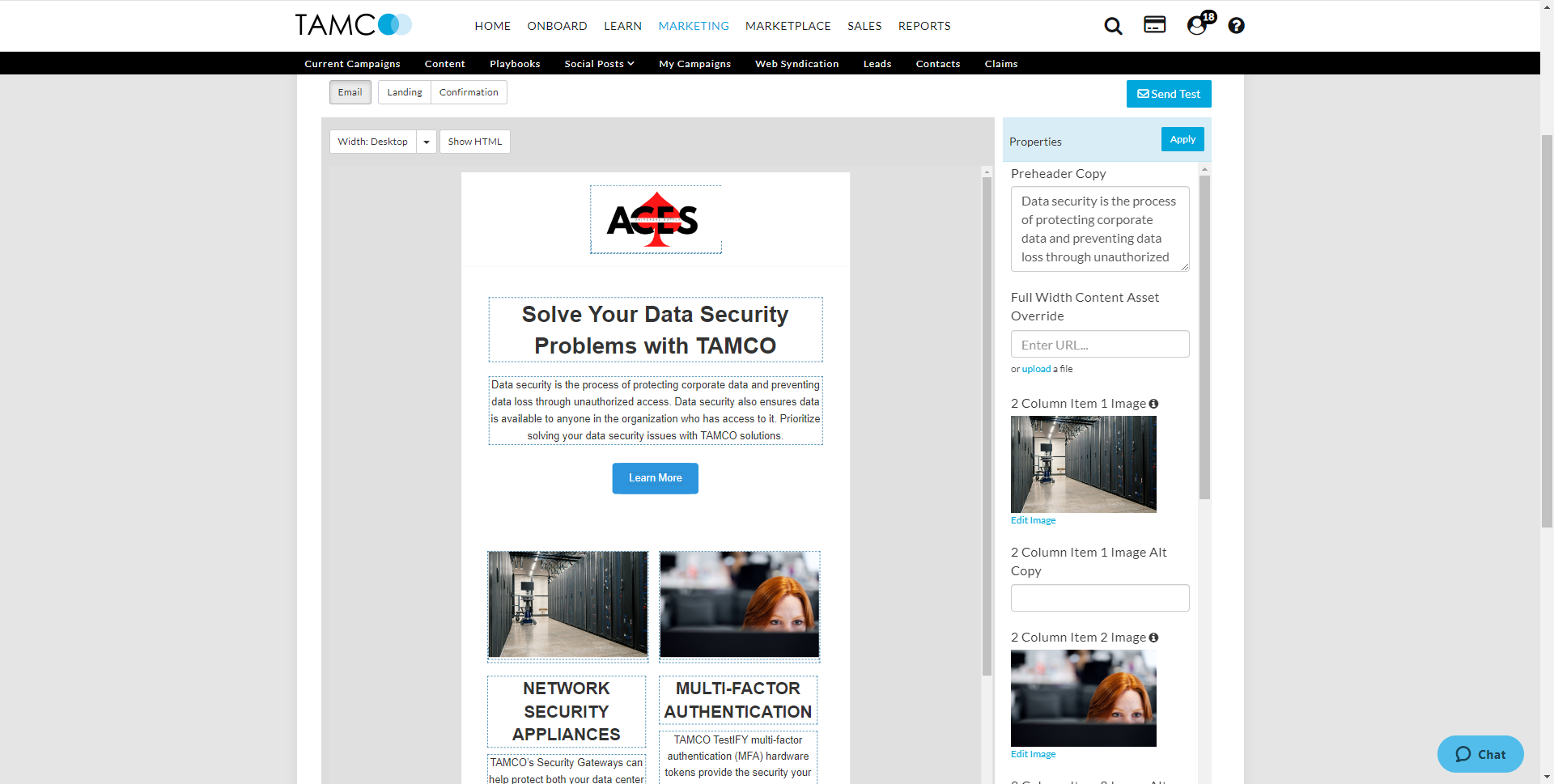- Through-channel marketing is vital to sales partner relationship development and revenue generation.
- Like many areas of digital marketing, through-channel marketing can be enhanced, scaled and customized through automation.
- Experts expect through-channel marketing automation (TCMA) use to increase this year.
- Simplicity is a dominant theme in TCMA for both vendors and partners.
- TCMA faces many of the same challenges as other marketing and channel initiatives (strong content, partner engagement, etc.).
- In addition to ease of use, flexibility and reporting are key TCMA platform attributes.
- Even simple TCMA programs require at least some level of partner training.
8 Fundamentals of Through-Channel Marketing Automation
Through-channel marketing automation delivers significant benefits to your company and your partners. It builds trust between your teams, helps you and your partners generate revenue, and its importance is on the rise. Predictions of greater through-channel marketing activity this year, originally detailed in our 2022 partner program predictions, were proven in our March Customer Event. This event revealed that companies are investing more in through-channel marketing than in to-channel and for-partner marketing combined.
 You can dig deeper into the benefits of through-channel marketing in our article 6 Best Practices for Through-Partner Communications.
You can dig deeper into the benefits of through-channel marketing in our article 6 Best Practices for Through-Partner Communications.
Like all areas of marketing, through-channel marketing can benefit significantly from automation. To dig into this vital subject, we turned to eight channel marketing leaders for insight into through-channel marketing automation fundamentals and some best practices. Our expert panelists include:
- Amy Bailey, Senior Vice President of Marketing for technology solutions brokerage Telarus
- Heather Tenuto, Chief Revenue Officer for partner relationship management (PRM) and channel management platform provider Zift Solutions
- Khali Henderson, Senior Partner for channel consultancy and technology marketing firm BuzzTheory
- Kris Blackmon, Chief Channel Officer for channel consultancy JS Group
- Kristine Stewart, founder and CEO of channel consultancy The Lexington Group
- Marie Steyl, a longtime marketing and channel expert with leading tech companies
- McKinley Thompson, Senior Global Partner Marketing Manager for communications and risk insights provider Smarsh
- Rich Long, Vice President of Channels for unified call and conversation recording platform Dubber
Want to skip ahead? Check out our eight fundamentals of TCMA:
- Ease of Use is a Top TCMA Platform Requirement
- Speed to Market Drives TCMA Usage in 2022
- Attribution is a Critical Function for TCMA
- Lack of Time and Training Are Barriers to TCMA Adoption
- Content is Key to TCMA Success
- Reporting Is Vital to TCMA Selection
- Make MDF Claims Easier with TCMA
- Get Feedback
What is Through-Channel Marketing Automation?
Through-channel marketing automation (TCMA) applies marketing automation’s scale and customization power to the indirect sales channel. Through TCMA, technology vendors and service providers can develop and deploy turnkey messaging and digital campaigns that help their partners go to market with their products and services.
McKinley Thompson of Smarsh defines TCMA this way: “Through-partner marketing is the enablement of your partners to communicate your message to prospects and customers through various marketing tactics. A TCMA platform is a tool that enables these partner marketing initiatives at scale and makes it as easy as possible for partners to promote your products and solutions on your behalf.”
Kris Blackmon of JS Group defines TCMA similarly while emphasizing the ability for vendors to leverage the local strengths of agents in their markets without suffering messaging confusion or brand dilution.

“TCMA is a SaaS solution that enables vendors to distribute a cohesive value proposition, brand persona and marketing message through indirect channels,” Blackmon says. “Partners have strong voices in their local markets but often lack robust marketing skills. And vendors work hard on their messaging and don’t want it diluted or have their message lost somewhere along the way. With TCMA, vendors make it easy for partners to represent their brands, deploy marketing campaigns, generate leads and track those leads through the funnel.”
That focus on lead and customer lifecycle management is essential to developing a successful channel partner engagement plan, says BuzzTheory’s Khali Henderson. “It’s true that sales partners are often better on their feet, face-to-face with customers, than they are at marketing,” she says. “TCMA can provide them with turnkey programs they can use to generate more in-person opportunities, but it also empowers those partners to compete on equal footing in the digital realm without becoming experts in digital marketing tactics and platforms. Partners value that, and vendors that get it right win on two fronts— the direct sales they generate from those efforts and the uptick in overall engagement and mindshare they gain when they help partners grow their businesses.”
Channel marketer Marie Steyl details the pros and cons of TCMA for the vendor and the partner. “Brands benefit from TCMA because it enables their local partners to create brand-compliant marketing materials and effectively manage their co-op dollars,” she says. “Brands include manufacturers, suppliers, distributors and providers of services with a distributed network of partners (dealers, agents, franchisees, operators, sales reps, retailers or whatever the industry label demands). These partners have a significant impact on the brand’s ability to sell products and services in a given local area. Because many brands have hundreds or thousands of local partners across the nation or even the world, it can be challenging to execute cohesive corporate marketing campaigns at scale without a TCMA platform
Steyl adds that partners benefit from TCMA because it empowers them to easily create brand-compliant marketing materials at a subsidized cost. “Because local partners are often small business owners or managers with a lot on their plates, they don’t have a lot of time or resources to devote to marketing,” she says. “Therefore, brand compliance isn’t a high priority for many partners, especially those that sell competing products and services simultaneously, such as telecommunications dealers. Through-channel marketing automation solves for that by providing simple, scalable and cost-effective marketing solutions. The platform provides marketing templates and resources that match the current corporate campaign and can be customized for increased relevancy within their local market.”

8 Fundamentals of Through-Channel Marketing Automation from Top Channel Partner Programs
We dug into the nuts and bolts of TCMA with our experts and came out with eight fundamentals that you can use in your through-channel marketing plans.
1. Ease of Use is a Top TCMA Platform Requirement
Our expert panelists emphasized that a key requirement of TCMA platforms is easing campaign execution for partners.
Sales partners don’t have the time to decode complicated tools and systems, says Steyl. “As a seasoned user of various multinational vendor TCMA systems, I rate ease-of-use as the top requirement for any TCMA system,” she says. “If a TCMA system is too complicated to use, a channel partner with multiple other business priorities will simply not bother to use it.
“Partners want a one-stop-shop where they can easily complete essential channel marketing tasks, such as accessing logos, templates, promotional material and visibility of MDF (or co-op funds).”
 Steyl’s list of typical components includes:
Steyl’s list of typical components includes:
- A simple, step-by-step streamlined workflow
- A library of compliant and customizable marketing assets
- Governance, including brand and co-branding guidelines
- Robust analytics to track and measure performance and fund usage
- An efficient portal from which marketing programs can be launched, tracked and measured
The Lexington Group’s Kristine Stewart agrees, noting that a TCMA platform should provide sales partners with:
- The ability to easily operationalize asset delivery
- A simple way for partners to see and spend their marketing funds
- An option to get localized/translated content
- Access to analytics and customer insights such as predictive modeling
2. Speed to Market Drives TCMA Usage in 2022
As we discussed earlier, through-channel marketing is on the rise in 2022. And so is automation, according to our experts.
Heather Tenuto from Zift summed it up: “Any time you have increasing demand for a multistep or complicated process, the demand for automation rises with it,” she says. “Partners need platforms that enable them to go to market quickly and easily. And so do vendors. They need to deploy and update assets across their entire partner base easily. Given the speed of innovation in our space and ongoing talent shortages, TCMA fills a vital business need for vendors that will only grow over time.”
 Thompson from Smarsh agrees with Tenuto about the importance of time-to-market for vendors and their partners. “The ability to rapidly customize and execute brand-compliant marketing activities that resonate with the market versus completely starting from scratch saves both parties time and money, allows for scale and helps you demonstrate partnership success quickly,” Thompson says. “A new and promising partnership can quickly be put at risk if processes, asset creation and approval cycles cause delay. TCMA can aid in the speed-to-market and ensure you stay top of mind with partners and demonstrate your commitment to them and their success from the beginning.”
Thompson from Smarsh agrees with Tenuto about the importance of time-to-market for vendors and their partners. “The ability to rapidly customize and execute brand-compliant marketing activities that resonate with the market versus completely starting from scratch saves both parties time and money, allows for scale and helps you demonstrate partnership success quickly,” Thompson says. “A new and promising partnership can quickly be put at risk if processes, asset creation and approval cycles cause delay. TCMA can aid in the speed-to-market and ensure you stay top of mind with partners and demonstrate your commitment to them and their success from the beginning.”
Henderson from BuzzTheory notes that time-to-market is also vital for channel programs to hit their numbers. “Delayed market entry is the greatest threat to any growth projection,” she says. “Channel programs aren’t immune from that reality. TCMA gives you instant scale across your indirect channels for accelerated product rollouts, ramp-ups and promotions.”
3. Attribution is a Critical Function for TCMA
Smarsh’s Thompson also sees TCMA as a valuable attribution tool. “Channel marketing attribution is something that every company has struggled with at one time or another, given the breadth of marketing tactics and limited budget dollars. If you can’t demonstrate the success of a channel-based marketing or sales approach to leadership, budget will go elsewhere, and the channel will never reach its full potential. The ability to report on marketing activities with partners from a centralized place and attribute the impact of these activities to achieving your overall marketing objectives is a central benefit of TCMA.”
Attribution is critical for partners as well as vendors; TCMA should deliver both, says Dubber’s Long. “[Partners] should be able to use the engine to track effectiveness and capture leads. A TCMA tool should be able to sync with the partners CRM tools for greater efficiency and visibility,” Long says. “If the TCMA tool is hosted by a supplier, that supplier should be able to … track the usage by the partner community to track effectiveness themselves, especially tied to MDF/co-op requests and program structures.”
4. Lack of Time and Training Are Barriers to TCMA Adoption
When discussing the challenges of TCMA adoptions for partners, JS Group’s Blackmon observes that time – or a lack thereof – is make or break.
“For partners, it’s really a matter of truly taking advantage of these offerings and putting them into action in their practices,” Blackmon says. “Lots of partners are small businesses where one person can be the CEO, head of sales and head of marketing, and sometimes it can be hard to carve out time for marketing no matter how easy vendors make it.”
Dubber’s Long agrees. “Time and interest will always be a challenge for partners adopting TCMA,” he says. “It’s helpful for marketing teams at a supplier to spend [one-on-one] time with the key partners to help design initial campaigns and social media outreach to foster ongoing adoption.”
Lexington Group’s Stewart also blames low usage on a lack of training on how to use TCMA platforms, which are often not intuitive or even difficult to use.
Henderson agrees, “Untrained partners can waste valuable time, becoming frustrated and unwilling to use the portal and less invested in the vendor partnership. Partners will always choose the path of least resistance.”
 Long adds, “If the partners are not using the tool, the supplier’s investment isn’t realized. Wherever possible, making the use of TCMA part of a program’s requirements or rewarding for its usage is key. This way, a supplier’s field sales team can then begin to adopt the usage of the TCMA and its results into conversations they are already having and make it a strategic part of the engagement.”
Long adds, “If the partners are not using the tool, the supplier’s investment isn’t realized. Wherever possible, making the use of TCMA part of a program’s requirements or rewarding for its usage is key. This way, a supplier’s field sales team can then begin to adopt the usage of the TCMA and its results into conversations they are already having and make it a strategic part of the engagement.”
Training on TCMA may need to start with marketing 101. Many sales partners are novice marketers and might need training in basic marketing concepts like multitouch campaigns. “Consistency is key,” says Bailey from Telarus. “Many times, we see partners send an email and think the leads will just come rolling in. They don’t realize a successful campaign needs to touch the reader on a consistent basis.”
5. Content is Key to TCMA Success
Dubber’s Long notes that TCMA is, like all marketing, about content, and content challenges can impact TCMA results. “Keeping the content fresh and relevant for partners is a challenge,” he says. “Suppliers must constantly make the partners aware of the new content and often take the lead with key partners to ensure they are using the tool often. …Creating content that is industry-specific, vertical-specific helps usage and isn’t always just about one supplier.”
Bailey from Telarus says vendor-neutral content is critical for partners who position their firms as unbiased advisers. “Channel programs want to push their message to the end-user,” she says. “Partners want to send more generic content about the topic at hand, not the specific supplier pushing their solution. For example, partners want to push a cybersecurity email to their customer base, not an email from a specific supplier about what they do in the world of cybersecurity.”
6. Reporting Is Vital to TCMA Selection
 When selecting a TCMA platform, Thompson from Smarsh says reporting is vital. “Having the ability to report on marketing performance and provide in-depth analytics that demonstrate ROI should also be a top consideration when selecting a tool,” she says. “Measurable results are important to the success of any partnership, and marketing activity is no exception. Being able to analyze the success (or failure) of a campaign can provide both parties with invaluable insight into if your joint offerings, messaging, and value proposition resonates with customers and prospects and can inform larger strategic areas of the partnership if leveraged properly.”
When selecting a TCMA platform, Thompson from Smarsh says reporting is vital. “Having the ability to report on marketing performance and provide in-depth analytics that demonstrate ROI should also be a top consideration when selecting a tool,” she says. “Measurable results are important to the success of any partnership, and marketing activity is no exception. Being able to analyze the success (or failure) of a campaign can provide both parties with invaluable insight into if your joint offerings, messaging, and value proposition resonates with customers and prospects and can inform larger strategic areas of the partnership if leveraged properly.”
Thompson says that reporting can help drive partner engagement. “You should be consistently monitoring performance, discussing results, and refreshing the content available to partners to keep them coming back. I would recommend frequently looking at trends in new and repeat users, activity execution, and MDF claims and setting KPIs attached to the use of your TCMA tool as a way of measuring success in addition to the results of the individual marketing activities themselves. Look at partner engagement and success indicators as a result of your TCMA tool, in addition to marketing results tied to prospects and customers. The two are equally important.”
7. Make MDF Claims Easier with TCMA
Executing campaigns and tracking leads are critical capabilities for TCMA platforms, but our panelists say they also should take some of the headaches out of MDF programs for both the vendor and their partners.
 “There needs to be robust capabilities to support MDF initiatives, including an easy way for partners to supply proof of performance data for MDF reimbursement,” says JS Group’s Kris Blackmon.
“There needs to be robust capabilities to support MDF initiatives, including an easy way for partners to supply proof of performance data for MDF reimbursement,” says JS Group’s Kris Blackmon.
The Lexington Group’s Stewart says ideally, a platform also would make it “easy to access funds for purchase and specifically for claims.”
“If simple and easy to use, [TCMA is] a great way to spend their all too often underspent MDF,” says Stewart. “In particular, for those partners that can’t afford much in the way of their own marketing resources.”

She adds that vendors can make an impact by enabling partners to spend MDF for “access to a creative service team or even a virtual marketing concierge end-to-end service.”
8. Get Feedback
Zift’s Tenuto encourages vendors to gather partner feedback on their TCMA initiatives during their channel partner program QBRs. “It’s important to know how your partners perceive your TCMA platform,” she says. “Find out what your partners do and don’t like about it and dig into why some partners are successful with it and others are not. Take what you learn to improve your program internally and develop best practices for partners externally.”
Zift takes feedback seriously and is pleased that the ZiftONE platform was ranked No. 1 for TCMA in the Spring 2022 report by G2, the largest software marketplace with unbiased, validated buyer reviews.
With ZiftONE, you can manage all channel marketing materials in one place and create customized marketing campaigns – emails, co-brandable collateral, social media posts and microsites – with no coding required.
All of us at Zift are thrilled that channel marketers told G2 they love ZiftONE’s capabilities and we’re especially gratified to hear that they can count on our people-powered support. Here’s just one example:

“The people at Zift are always eager to hear how their platform can better improve to serve your company best. The platform is continually growing with new valuable features, and the reps will always take time out of their day to ensure you have the training and detail needed to maximize the resources.”
We’d be happy to show you how our platform and team can help you reach your through-channel marketing goals. Contact our team to learn more today.
Laz Gonzalez
Laz Gonzalez is Chief Strategy Officer at Zift Solutions. A prominent industry analyst and thought leader, Gonzalez brings unparalleled channel expertise to Zift and has served as strategic adviser to leading B2B channel programs worldwide.





